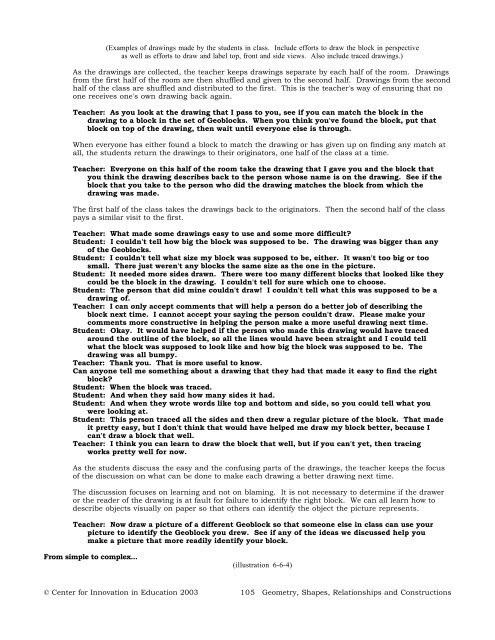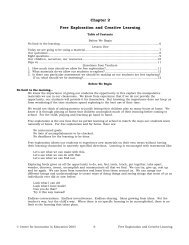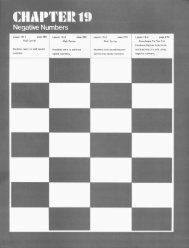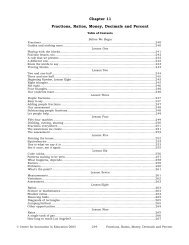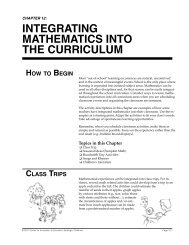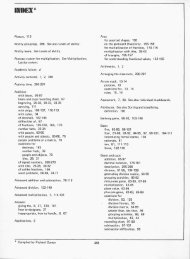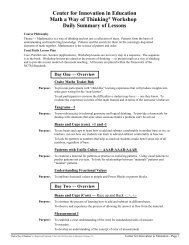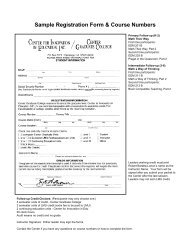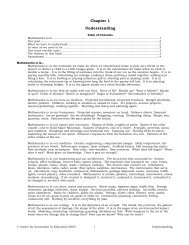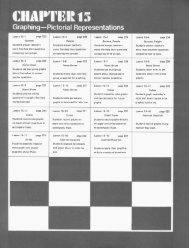Chapter 6 - Center for Innovation in Education
Chapter 6 - Center for Innovation in Education
Chapter 6 - Center for Innovation in Education
Create successful ePaper yourself
Turn your PDF publications into a flip-book with our unique Google optimized e-Paper software.
(illustration 6-7-2)(Teacher draws one l<strong>in</strong>e and then draws another directly on top of it. This will have to be described <strong>in</strong>the accompany<strong>in</strong>g caption, s<strong>in</strong>ce a l<strong>in</strong>e drawn on top of a l<strong>in</strong>e looks a lot like a s<strong>in</strong>gle l<strong>in</strong>e.)Student: No! Not on-top touch<strong>in</strong>g. Meet<strong>in</strong>g touch<strong>in</strong>g. They touch at the ends. Two straight l<strong>in</strong>estouch<strong>in</strong>g at their ends.(illustration 6-7-3)(Straight l<strong>in</strong>e with a curved l<strong>in</strong>e touch<strong>in</strong>g the straight l<strong>in</strong>e at both ends.)Student: No. See, the l<strong>in</strong>e on top isn't straight, its curved. Both l<strong>in</strong>es have to be straight.Teacher: Okay. Two straight l<strong>in</strong>es touch<strong>in</strong>g. What about this?(illustration 6-7-4)(Two straight l<strong>in</strong>es cross<strong>in</strong>g.)Student: That's four angles all together. There is a different angle between each time there aretwo l<strong>in</strong>es. You said to draw only one angle. Two straight l<strong>in</strong>es touch<strong>in</strong>g just at their ends.(illustration 6-7-5)(Two straight l<strong>in</strong>es touch<strong>in</strong>g—an angle.)How do we know?...(illustration 6-7-6)(Two angles. Each drawn with sides the same length. The angle on the left is bigger than the angle onthe right.)Teacher: Which of these two angles is bigger?Student: The one on the left.Teacher: How do you know?Student: Because it is. It opens up farther.(illustration 6-7-7)(Illustration from above with the sides of the smaller angle on the right drawn longer.)Teacher: Now which angle is bigger?Student: They're still the same size. All you did was make that one have longer sides.Will any of our students know this at the start? As our students measure angles, they will see that theright angle <strong>in</strong> the corner of the room is no bigger and no smaller than the right angle <strong>in</strong> the corner of abox. They will see that when we measure angles, we are measur<strong>in</strong>g how far a l<strong>in</strong>e has turned, not howlong the l<strong>in</strong>e might be.Teacher: Fold your paper anywhere, like this.(illustration 6-7-8)(Piece of paper with a corner folded over at an odd angle.)Teacher: Look at the edge of your fold. Estimate where the middle of this edge might be. Nowfold your paper aga<strong>in</strong> so that one half of that edge of your first fold l<strong>in</strong>e is exactly on top ofthe other half of the edge.Check with your neighbor and have your neighbor check you, so I can see if I have made my<strong>in</strong>structions clear.(illustration 6-7-9)(Second fold of paper. A right angle is <strong>for</strong>med by the paper fold. Indicate <strong>in</strong> the caption the corner ofthe fold that the follow<strong>in</strong>g dialog is discuss<strong>in</strong>g.)Teacher: I want you to use the paper you have folded as your angle-measur<strong>in</strong>g device. See howmany objects or places <strong>in</strong> the room you can f<strong>in</strong>d that are exactly the same angle as the angleyou just folded. Make a list of everyth<strong>in</strong>g you f<strong>in</strong>d. You may work with a partner if youwish. If you need a word spelled, you may br<strong>in</strong>g me your spell<strong>in</strong>g notebook.We start with folded paper and an angle that is easy to identify. We can measure angles endlessly.© <strong>Center</strong> <strong>for</strong> <strong>Innovation</strong> <strong>in</strong> <strong>Education</strong> 2003 109 Geometry, Shapes, Relationships and Constructions
Teacher: What angles can you f<strong>in</strong>d that are bigger than the angle of your folded paper? Whichangles are smaller? How do you know?What is meant by bigger? What is meant by smaller? The concept of angle develops slowly over time.There is no hurry <strong>in</strong> the teach<strong>in</strong>g that we do.Teacher: The angle that we folded is called a "right angle." It is called "right" no matter whichway it is turned. The angles that you found that were smaller than a right angle are called"acute angles." The angles that are larger than a right angle are called "obtuse angles."We <strong>in</strong>troduce vocabulary when the vocabulary has a use.Teacher: Here is a device we can use <strong>for</strong> compar<strong>in</strong>g angle sizes.(illustration 6-7-10)(Equipment: One straw, two sticks or dowels th<strong>in</strong> enough to fit <strong>in</strong>side the straw, some mask<strong>in</strong>g tape.Tape the sticks, one each, protrud<strong>in</strong>g from each end of the straw. Bend the straw <strong>in</strong> the middle. This isan angle measur<strong>in</strong>g device.)Teacher: How can we use this device to help us know which angles might be bigger or smallerthan another?Make a list of at least ten objects <strong>in</strong> the room. The first object that you put on your list shouldhave at least one small angle. The next object should have an angle bigger than the anglethat you measured <strong>for</strong> object number one. The third object should have an angle bigger thanthe angle on object number two. Each new object that you add should have an angle biggerthan the angle on the object just be<strong>for</strong>e it. You may work with a partner <strong>in</strong> creat<strong>in</strong>g your list.The act of compar<strong>in</strong>g angle sizes helps students focus on the attributes be<strong>in</strong>g measured and should bedone <strong>in</strong>itially without us<strong>in</strong>g any standard units of measure.By degrees...Teacher: What k<strong>in</strong>ds of standard measurements do we use when we measure how long th<strong>in</strong>gsare?Students: Inches... Feet... Meters... Miles... Yards...Teacher: What k<strong>in</strong>ds of standard measurements do we use when we measure weight or mass?Students: Ounces... Pounds... Grams... Kilograms... Tons...Teacher: What is the standard unit we use when we measure angles?If our students already know the answer is degrees, there is one less th<strong>in</strong>g we have to teach this year.Teacher: We measure angles with degrees. The degrees <strong>for</strong> angles are not the same degrees weuse <strong>for</strong> tak<strong>in</strong>g temperatures. When we measure distances, we use a ruler or tape measure.When we measure degrees <strong>for</strong> angles we use a protractor.(illustration 6-7-11)(A protractor. The follow<strong>in</strong>g dialogue assumes that the protractor has an arrow at the midpo<strong>in</strong>t of thestraight edge <strong>for</strong> position<strong>in</strong>g. The assumption is also made that there are double rows of numbers onthe protractor.)Teacher: I've drawn an angle on the overhead. Where do you th<strong>in</strong>k the straight edge of theprotractor might go on the angle?Student: On one of the sides of the angle.Teacher: Why?Student: Because it's straight, too.Teacher: Where do you th<strong>in</strong>k this arrow <strong>in</strong> the middle of the straight edge of the protractor ismeant to po<strong>in</strong>t?Student: In the middle of the side of the angle.Teacher: Like this?(illustration 6-7-12)(Angle with the straight edge of the protractor on one of its sides. The center-po<strong>in</strong>t arrow on theprotractor po<strong>in</strong>t<strong>in</strong>g to the midpo<strong>in</strong>t of the angle's side.)Student: Yes.Teacher: Then what size would the angle be?© <strong>Center</strong> <strong>for</strong> <strong>Innovation</strong> <strong>in</strong> <strong>Education</strong> 2003 110 Geometry, Shapes, Relationships and Constructions
Student: Either 0 or 180. Probably 180, because it's too big to be 0.Teacher: Then let's measure a different angle.(illustration 6-7-13)(Angle larger than the angle <strong>in</strong> the illustration above with the straight edge of the protractor on one ofits sides. The center-po<strong>in</strong>t arrow on the protractor po<strong>in</strong>t<strong>in</strong>g to the midpo<strong>in</strong>t of the angle's side.)Teacher: Is this angle the same size as the previous angle?Student: No it's bigger.Teacher: What size does the protractor say it is?Student: Zero or 180. So, that can't be the right way to measure it.Teacher: Does the angle change <strong>in</strong> size if we make the sides longer?Student: The angle's still the same.Teacher: So, if we make the sides longer or shorter, and the angle is still the same, what part ofthe angle has not changed?If our students do not know, we tell them that what rema<strong>in</strong>s unchanged is the turn the l<strong>in</strong>es have made.Student: The amount of turn the l<strong>in</strong>es have made?Teacher: We can measure the amount of turn by putt<strong>in</strong>g the protractor's arrow at the place wherethe l<strong>in</strong>es meet. The meet<strong>in</strong>g po<strong>in</strong>t <strong>for</strong> the l<strong>in</strong>es is called the vertex. Let's see what happens ifwe put the arrow at the vertex.Now, where do you th<strong>in</strong>k the straight side of the protractor goes?Student: On the bottom l<strong>in</strong>e of the angle.(illustration 6-7-14)(Protractor correctly placed on the angle.)Teacher: How many degrees are <strong>in</strong> this angle?Student: Do we use the top number or the bottom number?Teacher: Look at the side of the angle where we put the straight edge of the protractor. Whatnumbers are there?Student: Zero and 180.Teacher: Which number do you th<strong>in</strong>k represents a more reasonable place to start?Student: Zero?Teacher: That makes sense to me. We usually start count<strong>in</strong>g with the smallest numbers first.Student: Then what are the other numbers there <strong>for</strong>?Teacher: Let's measure this angle first and then we'll see. What is the size of this angle?Student: It looks like it's pretty close to 30 degrees.Teacher: Then let's see what happens if we put the protractor on the other side of the angle.(illustration 6-7-15)(Protractor correctly placed on the opposite side of the same angle.)Teacher: What size is the angle now? Remember, we start with zero.Student: About 30 degrees aga<strong>in</strong>.Teacher: Which numbers did you use this time?Student: The other ones.Students who have had experience measur<strong>in</strong>g angles <strong>in</strong><strong>for</strong>mally have little difficulty comprehend<strong>in</strong>gthat smaller or larger angles and smaller or larger numbers on their protractors go hand <strong>in</strong> hand.Teacher: Now I want you to try measur<strong>in</strong>g angles that you make <strong>for</strong> yourselves. Remember, thearrow po<strong>in</strong>ts to the vertex. What's the vertex?Students: The place where the l<strong>in</strong>es meet.Teacher: And the straight edge of the protractor goes along one of the edges of the angle. Does itmake any difference which edge you use?Students: No.Teacher: Why not?Student: Because the angle is the same size either way.Angular explorations...Once our students can measure angles, we give them problems to explore. Calculators are allowed.© <strong>Center</strong> <strong>for</strong> <strong>Innovation</strong> <strong>in</strong> <strong>Education</strong> 2003 111 Geometry, Shapes, Relationships and Constructions
Use your protractor to f<strong>in</strong>d the number of degrees <strong>for</strong> all the different angles <strong>in</strong> your Pattern Blockor Power Block set. If it makes it easier <strong>for</strong> you and your protractor, you may trace each blockon paper and measure the angles of the trac<strong>in</strong>g and not the block itself.How many different angles <strong>in</strong> each set?Which angle is the most common <strong>in</strong> the set?Which angle occurs the fewest times?What is the sum of all the angles <strong>for</strong> each piece?Does every piece have a different sum?Is there a pattern we can f<strong>in</strong>d <strong>for</strong> the sum of all the angles <strong>in</strong> some pieces that might tell us thesums of angles <strong>for</strong> other pieces <strong>in</strong> the set?Is there a pattern we can f<strong>in</strong>d <strong>for</strong> the number of sides of a polygon and the total <strong>for</strong> degrees?What is the sum of all the angles around a tessellat<strong>in</strong>g po<strong>in</strong>t?(illustration 6-7-16)(Show two or three examples of what is meant by a tessellat<strong>in</strong>g po<strong>in</strong>t.)Which shapes fit together to <strong>for</strong>m a straight l<strong>in</strong>e?What is the sum of the angles of these shapes that went <strong>in</strong> to mak<strong>in</strong>g the straight l<strong>in</strong>e?(illustration 6-7-17)(Show what is meant by shapes that fit together to <strong>for</strong>m a straight l<strong>in</strong>e.)We can tear the corners off this one triangle and fit them <strong>in</strong> a l<strong>in</strong>e.(illustration 6-7-18)(Show a carefully cut paper triangle <strong>in</strong>tact. Then show the same triangle with the three corners torn off.Then show the three corners fitted together so that their bottom edge is a straight l<strong>in</strong>e.)Is this the only triangle whose three corners fit together <strong>in</strong> a l<strong>in</strong>e?What is the sum of all the angles <strong>in</strong> this triangle?Are there any triangles with a different sum?What do we learn when we measure the angles made by h<strong>in</strong>ged mirrors?What shape appears when the image of a straight l<strong>in</strong>e is reflected <strong>in</strong> h<strong>in</strong>ged mirrors placed 90°apart?(illustration 6-7-19)(Show a top down view of two mirrors at 90° angles to one another, with a l<strong>in</strong>e drawn between them as if<strong>for</strong>m<strong>in</strong>g the cross bar of the letter A. Do not show the reflected image, just the setup.)What angles can we set the mirrors to, to have the images of the l<strong>in</strong>e be regular polygons?Is there a connection between the size of the angles and the number of sides <strong>in</strong> the polygons?Can you plan the angle <strong>for</strong> the mirror and predict the number of sides that you will get? Willdivid<strong>in</strong>g 360° by the number of sides on the polygon give you a clue?What other patterns are there to see?What else can you discover?What rules can you <strong>in</strong>vent?360°...Teacher: How many degrees on your protractor?Students: One hundred and eighty degrees.Teacher: Your protractor measures half a circle or half a turn. How many degrees do you th<strong>in</strong>kare <strong>in</strong> a full circle or a full turn? You may use your calculators to f<strong>in</strong>d out.Students: Three hundred and sixty degrees.Teacher: Yes, there are three hundred, sixty degrees <strong>in</strong> a circle. Why?Students: ?Why are there 360° <strong>in</strong> a circle? Why not 400°? Why not 25°? Were the first circles seen by humanslong ago measured <strong>in</strong> degrees? Does the full moon that we see on a summer night have 360 written onits face? Were there any circles at the start of history that had numbers written <strong>in</strong>? Who decided howmany degrees were <strong>in</strong> a circle and why?Teacher: How many different numbers can you divide evenly <strong>in</strong>to 360? You may use yourcalculator to help you f<strong>in</strong>d out. You may work with a partner if you wish. Every time youf<strong>in</strong>d a way, call it out and I'll write it on the board.© <strong>Center</strong> <strong>for</strong> <strong>Innovation</strong> <strong>in</strong> <strong>Education</strong> 2003 112 Geometry, Shapes, Relationships and Constructions
1234568910121518202430364045607290120180360Teacher: Numbers that divide <strong>in</strong>to other numbers without leav<strong>in</strong>g any rema<strong>in</strong>der are calledfactors of that number. So far, we have found 24 factors <strong>for</strong> 360. Are there any patterns <strong>in</strong> thefactors we have found that might tell us if we've found them all? Can anyone see a pattern<strong>in</strong> the factors if I pair the biggest factor with the littlest, the next biggest with the nextlittlest and so on, like this?1 3602 1803 1204 905 726 608 459 4010 3612 3015 2418 20Teacher: If you would like a h<strong>in</strong>t, use your calculator to multiply each pair of factors and tell mewhat you get.Students: 360 (aga<strong>in</strong> and aga<strong>in</strong>).Teacher: How many different factors can you f<strong>in</strong>d <strong>for</strong> 359? F<strong>in</strong>d<strong>in</strong>g factors means f<strong>in</strong>d<strong>in</strong>g howmany numbers divide evenly <strong>in</strong>to 359? Every time you f<strong>in</strong>d a way, call it out and I'll writeit on the board.1359Teacher: So far, we have found 2 factors. I thought there would be more. Its pretty easy to seethat 1 times 359 is 359.How many different factors can you f<strong>in</strong>d <strong>for</strong> 358?12179358Teacher: Let's pair these factors up the same way we did <strong>for</strong> 360.1 3582 179© <strong>Center</strong> <strong>for</strong> <strong>Innovation</strong> <strong>in</strong> <strong>Education</strong> 2003 113 Geometry, Shapes, Relationships and Constructions
Teacher: It looks like 360 can be divided evenly by many numbers, but not every number can. Ofall the numbers between 1 and 360, I wonder if 360 has the most factors. Can we f<strong>in</strong>d anynumber between 1 and 360 with more than 24 factors? That's a lot of numbers to f<strong>in</strong>d outabout. If we start with the little numbers first, maybe we can f<strong>in</strong>d some number patterns thatmake the search easier.Work with partners or groups. See how many different numbers you can f<strong>in</strong>d out about today.Any patterns that you f<strong>in</strong>d that make your work a little easier, we'll share with everybodyelse <strong>in</strong> class.How long would it take our students to f<strong>in</strong>d the numbers that divide evenly <strong>in</strong>to all the numbersbetween 1 and 360? It might take one child days and days. Thirty children <strong>in</strong> a room can do it thirtytimes as fast. Thirty children with parents at home to help can do it even faster.What might be learned through all this ef<strong>for</strong>t besides how to use a calculator to divide and multiply?People work<strong>in</strong>g together to f<strong>in</strong>d many answers is a more efficient way to get many answers thanwork<strong>in</strong>g by oneself.When we f<strong>in</strong>d patterns <strong>in</strong> the answers, the answers are easier to f<strong>in</strong>d.Numbers that are big do not always have more factors than numbers that are small.We also learn that there is a reason that a circle has 360°. People were look<strong>in</strong>g <strong>for</strong> patterns <strong>in</strong> numberslong be<strong>for</strong>e we were born. 360° has more factors than any smaller number has. More factors meansmore ways a circle of 360° can be divided equally without us<strong>in</strong>g fractions to describe the equalmeasurements. Perhaps there was more thought put <strong>in</strong>to math by the people who made math up thanwe thought.A question <strong>for</strong> another day might be: If 360° has more factors than any smaller number does, what isthe next larger number that has more factors than 360°?Lesson EightPurposeSummaryMaterialsTopicTopicTopicTopicTopicTopicConstructions...Learn to use a compass, protractor and straightedge to exploregeometric properties.We ask questions and pose challenges <strong>for</strong> our students thatguide their explorations with compass, protractor andstraightedge.Compass, protractor, straightedge, paper.See what you can make.Make two or more circles the same size.Use a compass to compare the lengths of l<strong>in</strong>es.Make two angles that are the same size.Copy an angle.Divide a l<strong>in</strong>e <strong>in</strong> half.(illustration 6-8-1)(Compass <strong>for</strong> use <strong>in</strong> draw<strong>in</strong>g circles.)When we hand out compasses to our students we know to teach them safety rules, just as we teachthem safety rules <strong>for</strong> scissors or pencils or any other object that has the potential <strong>for</strong> <strong>in</strong>jury. Once thesafety rules are understood, the compass is another manipulative <strong>for</strong> our students to explore.Teacher: This is a compass. See what you can make. If you wish to, you may use yourstraightedges and protractors as well.(illustration 6-8-2)(Student designs with compasses.)Questions we might ask to expand the range of geometric constructions our students create:Can you make two or more circles the same size?How do you know what size the circles are?Can you use your compass to measure the length of a l<strong>in</strong>e?Can you use your compass to tell if another l<strong>in</strong>e is the same length?Can you use your straightedge and your compass to draw two angles that are the same size?© <strong>Center</strong> <strong>for</strong> <strong>Innovation</strong> <strong>in</strong> <strong>Education</strong> 2003 114 Geometry, Shapes, Relationships and Constructions
(illustration 6-8-3)(Show how to use a compass and a straightedge to copy an angle. An example can be found on page 392of Geometry: An Investigative Approach.)Can you use a straightedge and a compass to copy a triangle?Can you use your compass and your straightedge to divide a l<strong>in</strong>e <strong>in</strong> half?(illustration 6-8-4)(Show how to use a compass to bisect a l<strong>in</strong>e. An example can be found on page 394 of Geometry: AnInvestigative Approach.)Can you use your compass and your straightedge to divide an angle <strong>in</strong> half?(illustration 6-8-5)(Show how to use a compass to bisect an angle. An example can be found on page 396 of Geometry: AnInvestigative Approach.)Can you use your compass and your straightedge to construct a perpendicular l<strong>in</strong>e?(illustration 6-8-6)(Show how to use a compass and straightedge to draw a perpendicular l<strong>in</strong>e. An example can be found onpage 397 of Geometry: An Investigative Approach.)Can you use your compass and your straightedge to construct a parallel l<strong>in</strong>e?(illustration 6-8-7)(Show how to use a compass and a straightedge to make two parallel l<strong>in</strong>es. An example can be found onpages 399-400 of Geometry: An Investigative Approach.)What else can you construct?What is it that we really want our students to know from our lessons on geometry? Do they really needto know how to measure angles or draw circles be<strong>for</strong>e they leave our class? What is the feel<strong>in</strong>g we wishour students to have about geometry from the lessons <strong>in</strong> our room? Do we expect them to memorizepredeterm<strong>in</strong>ed rules, or do we want them to ga<strong>in</strong> the understand<strong>in</strong>g that comes from explor<strong>in</strong>g l<strong>in</strong>es andshapes? Can we free ourselves to follow the direction of the child, not the direction of the book? If weask, "What can you create?" can we accept the creations and not wish <strong>for</strong> someth<strong>in</strong>g else?We teach geometry to construct images of mathematical relationships <strong>in</strong> our students' m<strong>in</strong>ds.Mathematics is more than numbers on a page.Lesson N<strong>in</strong>ePurposeSummaryMaterialsTopicTopicTopicTopicHomeworkLearn to be aware of the geometry <strong>in</strong> our lives.We ask our students to look more closely at what they alreadysee.Paper <strong>for</strong> writ<strong>in</strong>g lists.Make a list of rectangular shapes. What other shapes can welist?List the tessellations that you can f<strong>in</strong>d.What shall we look <strong>for</strong> today? Why are the th<strong>in</strong>gs that we seethe shape that they are?What angles, shapes, l<strong>in</strong>es <strong>in</strong> a bicycle?This is a lesson on look<strong>in</strong>g and wonder<strong>in</strong>g. Look<strong>in</strong>g andwonder<strong>in</strong>g questions can be sent home everyday.Awareness means...Look at the clouds. Why do the clouds <strong>for</strong>m billowy curves and not crystal-like squares? Look at thelightn<strong>in</strong>g. Why does the lightn<strong>in</strong>g <strong>for</strong>m jagged, streaked l<strong>in</strong>es and not curves? Look at the designs thew<strong>in</strong>d blows on the hot desert sand. Why is this the pattern of w<strong>in</strong>d on the sand and not any other?What shape is an apple, an orange, or a pear? Why have these tree-grow<strong>in</strong>g fruits taken unique shapesand not the same shapes as each other? Imag<strong>in</strong>e the mass of a mounta<strong>in</strong> or the depth of a canyonnearby. How did the mounta<strong>in</strong> rise up without fall<strong>in</strong>g over? How did the canyon get so deep without© <strong>Center</strong> <strong>for</strong> <strong>Innovation</strong> <strong>in</strong> <strong>Education</strong> 2003 115 Geometry, Shapes, Relationships and Constructions
fill<strong>in</strong>g <strong>in</strong>? Look at the structure of trees. How do the trees know to grow only as tall as their ownspecies and not any taller than that?We know how to teach about numbers and shapes. But how do we and our students learn to see themathematics <strong>in</strong> clouds?Awareness means learn<strong>in</strong>g to look.Teacher: Today, I want you and your partner to make a list of all the objects you can f<strong>in</strong>d thathave rectangular shapes. You may use your spell<strong>in</strong>g notebook if you need assistance <strong>in</strong>spell<strong>in</strong>g a word.What other k<strong>in</strong>ds of awareness questions might we ask <strong>for</strong> shapes?Are there more rectangular shapes <strong>in</strong> our room than any other k<strong>in</strong>d?If there are more rectangular shapes, is this just because we are <strong>in</strong> school?What might be the most common k<strong>in</strong>d of shape <strong>in</strong>side of school or out?How many different k<strong>in</strong>ds of shapes might we f<strong>in</strong>d just look<strong>in</strong>g out the w<strong>in</strong>dow?Teacher: What tessellations can you f<strong>in</strong>d? Th<strong>in</strong>k of where you might look at school, or at home,or on the way to and from anywhere.Where are there tessellations?In the fabrics used <strong>for</strong> cover<strong>in</strong>g furniture and mak<strong>in</strong>g clothes.In wrapp<strong>in</strong>g paper and wallpaper.In tiles and bricks that make up walls and floors.In fences and roofs and sidewalks.In leaves, flowers, animal sk<strong>in</strong>s and fish scales.In aerial view photos of cities and farms.Teacher: What objects or designs or angles or l<strong>in</strong>es can you make a list of today? Can you f<strong>in</strong>dan example of a shape or an angle or a l<strong>in</strong>e that no one else <strong>in</strong> our class has thought of be<strong>for</strong>e?We can make lists <strong>for</strong>:triangles squares rectangles quadrilateralstrapezoids parallelograms rotations reflected imagestessellations symmetry flips slidesright angles acute angles obtuse angles straight anglesvertical l<strong>in</strong>es horizontal l<strong>in</strong>es parallel l<strong>in</strong>es perpendicular l<strong>in</strong>esdiameters arcs perimeters circumferencessemicircles circles ellipses curved l<strong>in</strong>escubes spheres pyramids boxes of all k<strong>in</strong>dsTeacher: Today, I want you and your partner to look at just a s<strong>in</strong>gle object and make a list of allthe k<strong>in</strong>ds of angles, shapes and l<strong>in</strong>es that you can f<strong>in</strong>d. The object <strong>for</strong> today's observations isa bicycle. You may use your spell<strong>in</strong>g notebook if you need assistance <strong>in</strong> writ<strong>in</strong>g words.What other real-world items can our students exam<strong>in</strong>e <strong>for</strong> l<strong>in</strong>es, shapes and angles?wagons roller skates cars busseshouses fences build<strong>in</strong>gs bridgesfloors walls doors w<strong>in</strong>dowsbooks pencils writ<strong>in</strong>g paper rulersbaseballs footballs hockey pucks playground apparatusplay<strong>in</strong>g fields tennis courts jump<strong>in</strong>g ropes hopscotch pathsice r<strong>in</strong>ks ski jumps div<strong>in</strong>g boards swimm<strong>in</strong>g poolssidewalks roads runways riversescalators elevators stairways fire escapesdresses pants shirts shoestrees flowers fruits vegetablesdogs cats horses cowsmounta<strong>in</strong>s valleys fields streamszoos museums circuses planetariumsshelves racks fabric fibers© <strong>Center</strong> <strong>for</strong> <strong>Innovation</strong> <strong>in</strong> <strong>Education</strong> 2003 116 Geometry, Shapes, Relationships and Constructions
Lesson Ten is a lesson <strong>in</strong> us<strong>in</strong>g opportunities. A house built right across the street is an opportunity tohelp our students see the value of geometry and all the rest of math. We look <strong>for</strong> opportunities that letour students see how others use math. We look <strong>for</strong> opportunities that let our students use geometryand mathematics <strong>for</strong> themselves. We know that geometry and mathematics are more than numbers on apage. We use the opportunities that arise to pass this knowledge on.Us<strong>in</strong>g opportunities...Science:Our science lessons (<strong>Chapter</strong> 15) are filled with opportunities to use math:Liquids.....................................................................................000Magnify<strong>in</strong>g ...............................................................................000Seeds and plants......................................................................000Worms and other animals .........................................................000Boats .......................................................................................000Changes...................................................................................000Objects <strong>in</strong> water.......................................................................000Moonsh<strong>in</strong>e ...............................................................................000Build<strong>in</strong>g...................................................................................000Paper planes and kites.............................................................000Pendulums...............................................................................000Candles ...................................................................................000Ice cubes .................................................................................000Shadows ..................................................................................000Friction, <strong>for</strong>ce and motion.........................................................000When our students are us<strong>in</strong>g geometry <strong>in</strong> science, we connect their activity with the word geometry.We want our students to know that geometry is someth<strong>in</strong>g they use and someth<strong>in</strong>g they understand.Draw<strong>in</strong>g:What geometry is <strong>in</strong> a child's picture of a house?(illustration 6-10-1)(Two draw<strong>in</strong>gs of a house. First draw<strong>in</strong>g: K<strong>in</strong>dergarten child's two dimensional free-hand rendition ofa house, flatly drawn without perspective. Second Draw<strong>in</strong>g: Sixth grade child's ruler draw<strong>in</strong>g of ahouse, angular view <strong>in</strong> perspective.)Writ<strong>in</strong>g is a way we have of shar<strong>in</strong>g words. Draw<strong>in</strong>g is a way we have of shar<strong>in</strong>g the images <strong>in</strong> ourm<strong>in</strong>ds. Draw<strong>in</strong>g is an application of geometry.We know that the background our students br<strong>in</strong>g with them <strong>for</strong> geometry is build<strong>in</strong>g. Build<strong>in</strong>g meansexperienc<strong>in</strong>g <strong>for</strong>ms and shapes. As our students build, we can ask them to record <strong>in</strong> pictures whatthey have made. Their pictures may be draw<strong>in</strong>gs or trac<strong>in</strong>gs or paper pieces pasted down. Conceptsand images go hand <strong>in</strong> hand.Situations that arise:Computer applications like Logo extend our students' understand<strong>in</strong>g of geometry deliberately.Computer games like the classic Tetris extend our students' understand<strong>in</strong>g of geometry <strong>in</strong>cidentally.Both styles of learn<strong>in</strong>g—deliberate and <strong>in</strong>cidental—work together to help students understand and<strong>in</strong>ternalize what they come to realize.The P. T. A. is plann<strong>in</strong>g to raise money aga<strong>in</strong> this year by sell<strong>in</strong>g school T-shirts and sweatshirts. Lastyear, the shirts had the school name on it and noth<strong>in</strong>g more. Might we suggest to the P. T. A. that acreative use of the talent <strong>in</strong> our school would be a contest to pick a student-generated geometric designto put upon the shirts?What other uses of student-made designs might we f<strong>in</strong>d? Holiday wrapp<strong>in</strong>g paper. Posters to advertiseevents at school. Designs added to the clothes our students wear. B<strong>in</strong>der covers. Hall decorations.Illustrations on posters made to advertise books <strong>in</strong> the school's library.Are the angles on the play<strong>in</strong>g fields at school correctly measured out? Are all the corners <strong>in</strong> thebaseball diamond 90°? How many other play<strong>in</strong>g fields <strong>in</strong> sports use right angle at their corners?Which play<strong>in</strong>g areas use angles other than the right? What would happen <strong>in</strong> an ice hockey match if thewall beh<strong>in</strong>d the goal had right angles and not curves? Are races run around square tracks? What© <strong>Center</strong> <strong>for</strong> <strong>Innovation</strong> <strong>in</strong> <strong>Education</strong> 2003 118 Geometry, Shapes, Relationships and Constructions
would basketball be like if the hoop were triangular and not circular? What would soccer be like if thegoal were curved and not rectangular?Could the park<strong>in</strong>g lot <strong>for</strong> our school hold more cars if the park<strong>in</strong>g l<strong>in</strong>es were drawn a different way?Are the tables <strong>in</strong> the cafeteria usefully arranged <strong>for</strong> seat<strong>in</strong>g the most children com<strong>for</strong>tably? Is there abetter way the tables might be faced? How is geometry used to allocate space?How did Columbus f<strong>in</strong>d his way across the sea? Did he use geometry? Why did Columbus th<strong>in</strong>k theworld was round, not flat? When I look outside, the world looks flat to me.Why does it make a difference what time of day or night NASA launches a shuttle <strong>in</strong>to space? What isthe path around the earth that a satellite follows? Does the satellite's path copy the path that the moontravels around the earth or that the earth follows around the sun?How do the scientists know where the epicenter of an earthquake is? How do they know if the epicenteris <strong>in</strong> the middle of the ocean when no scientists live nearby to see the ocean shake? How can they tellhow far down below the ground the epicenter is, when none of them go down <strong>in</strong>side the ground to look?The puzzle we set out on a table to be pieced together dur<strong>in</strong>g free time is an application of geometry.What geometry and other k<strong>in</strong>ds of learn<strong>in</strong>g do we use when we play m<strong>in</strong>iature golf, or shoot pool, orplay air hockey at the local arcade?Creat<strong>in</strong>g opportunities...We make use of the opportunities that arise. We also create opportunities.(illustration 6-10-2)(A simple geometric figure drawn on geoboard record<strong>in</strong>g paper.)Teacher: Work with a partner to calculate the area of this shape. Be prepared to expla<strong>in</strong> yourassumptions and procedures to the rest of the class.How will the students know who is right and who is wrong? Will they use their geoboards to help themf<strong>in</strong>d a way?Other questions we might ask:Make up two more figures with different shapes that have the same area as the first figure. Expla<strong>in</strong>how you know your two draw<strong>in</strong>gs have the same area as the first.What is the highest number of right angles a polygon can have? Are there any polygons <strong>in</strong> whichyou cannot <strong>in</strong>clude a right angle? Give an explanation <strong>for</strong> the answers you f<strong>in</strong>d.What is the largest area you can put <strong>in</strong>side a shape made with a str<strong>in</strong>g two feet long? The ends ofthe str<strong>in</strong>g must meet so that the area has no open<strong>in</strong>gs. Expla<strong>in</strong> why you th<strong>in</strong>k your area is thelargest you could f<strong>in</strong>d.Can you draw a shape with straight sides and a perimeter of 20 units that will fit <strong>in</strong>side a shapewith a perimeter of 15? Show how or expla<strong>in</strong> why not.Can you draw a shape with straight sides and an area of 20 units that will fit <strong>in</strong>side a shape with anarea of 15? Show how or expla<strong>in</strong> why not.Choose two of these shapes to compare. Describe how they are alike and how they are different.(illustration 6-10-3)(Draw<strong>in</strong>gs of five different quadrilaterals labeled A, B, C, D, E.)Can you f<strong>in</strong>d a pattern that will help you f<strong>in</strong>d the number of new squares you need to add to onesquare <strong>in</strong> order to make the next-sized square?(illustration 6-10-4)(Consecutive squares made with Power Block squares.)This is a growth pattern. If you f<strong>in</strong>d a growth pattern, describe it so that someone else can see it,too. What other shapes have growth patterns that you can f<strong>in</strong>d? Describe the patterns that yousee.Which patterns of six connected squares that you cut from your graph paper will fold <strong>in</strong>to a box orcube? Which will not? Predict be<strong>for</strong>e you fold.(illustration 6-10-5)(A collection of six connected square shapes cut from graph paper.)© <strong>Center</strong> <strong>for</strong> <strong>Innovation</strong> <strong>in</strong> <strong>Education</strong> 2003 119 Geometry, Shapes, Relationships and Constructions
Our lessons <strong>in</strong> geometry help our students recognize and appreciate the geometry that exists <strong>in</strong> ourworld. We make awareness and wonder a part of school when we connect the <strong>in</strong>vestigat<strong>in</strong>g,experiment<strong>in</strong>g and explor<strong>in</strong>g that is a natural part of every child's life.1. How do we assess geometry?Questions from TeachersHow do we assess the awareness and the wonder that we teach? If we have <strong>in</strong>creased our ownawareness and wonder of the geometry that fills our lives, then we know we have made awareness andwonder a part of every student's life as well.Our assessments are also drawn from our observations of the work our students do <strong>in</strong> class. We knowthey have learned if they can:Construct images of mathematical relationships.Use spatial sense and visual imagery as problem-solv<strong>in</strong>g skills.F<strong>in</strong>d l<strong>in</strong>es of symmetry everywhere.Know the build<strong>in</strong>g that they do is part of math.Build and then describe.Associate the beauty of nature and the beauty of design with the beauty of math.Know the properties that different shapes have <strong>in</strong> common and that different shapes do not.Know what an angle is.Make constructions with a compass, a straightedge and a protractor.© <strong>Center</strong> <strong>for</strong> <strong>Innovation</strong> <strong>in</strong> <strong>Education</strong> 2003 120 Geometry, Shapes, Relationships and Constructions


